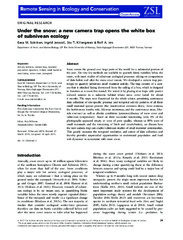| dc.contributor.author | Soininen, Eeva M | |
| dc.contributor.author | Jensvoll, Ingrid | |
| dc.contributor.author | Killengreen, Siw Turid | |
| dc.contributor.author | Ims, Rolf Anker | |
| dc.date.accessioned | 2016-04-01T07:21:13Z | |
| dc.date.available | 2016-04-01T07:21:13Z | |
| dc.date.issued | 2015-05-14 | |
| dc.description.abstract | Snow covers the ground over large parts of the world for a substantial portion of the year. Yet very few methods are available to quantify biotic variables below the snow, with most studies of subnivean ecological processes relying on comparisons of data before and after the snow cover season. We developed a camera trap prototype to quantify subnivean small mammal activity. The trap consists of a camera that is attached facing downward from the ceiling of a box, which is designed to function as a snow-free tunnel. We tested it by placing nine traps with passive infrared sensors in a subarctic habitat where snow cover lasted for about 6 months. The traps were functional for the whole winter, permitting continuous data collection of site-specific presence and temporal activity patterns of all three small mammal species present (the insectivorous common shrew, Sorex araneus, the herbivorous tundra vole, Microtus oeconomus, and the carnivorous stoat, Mustela erminea) as well as abiotic conditions (presence/absence of snow cover and subnivean temperature). Based on their successful functioning (only 6% of the photographs appeared empty or were of poor quality, whereas ca 80% were of small mammals and the remaining of birds and invertebrates), we discuss how the new camera trap can enable subnivean studies of small mammal communities. This greatly increases the temporal resolution and extent of data collection and thereby provides unpreceded opportunities to understand population and food web dynamics in ecosystems with snow cover. | en_US |
| dc.description | Published version. Source at <a href=http://doi.org/10.1002/rse2.2>http://doi.org/10.1002/rse2.2</a>. | en_US |
| dc.identifier.citation | Remote Sensing in Ecology and Conservation 2015, 1(1):29-38 | en_US |
| dc.identifier.cristinID | FRIDAID 1242446 | |
| dc.identifier.doi | 10.1002/rse2.2 | |
| dc.identifier.issn | 2056-3485 | |
| dc.identifier.uri | https://hdl.handle.net/10037/9088 | |
| dc.identifier.urn | URN:NBN:no-uit_munin_8660 | |
| dc.language.iso | eng | en_US |
| dc.publisher | Wiley | en_US |
| dc.rights.accessRights | openAccess | |
| dc.subject | Activity patterns | en_US |
| dc.subject | camera trap | en_US |
| dc.subject | mustelid | en_US |
| dc.subject | population dynamics | en_US |
| dc.subject | rodent | en_US |
| dc.subject | small mammal monitoring | en_US |
| dc.subject | snow cover | en_US |
| dc.subject | snowpack | en_US |
| dc.subject | VDP::Matematikk og Naturvitenskap: 400::Zoologiske og botaniske fag: 480::Økologi: 488 | en_US |
| dc.title | Under the snow: a new camera trap opens the white box of subnivean ecology | en_US |
| dc.type | Journal article | en_US |
| dc.type | Tidsskriftartikkel | en_US |
| dc.type | Peer reviewed | en_US |


 English
English norsk
norsk